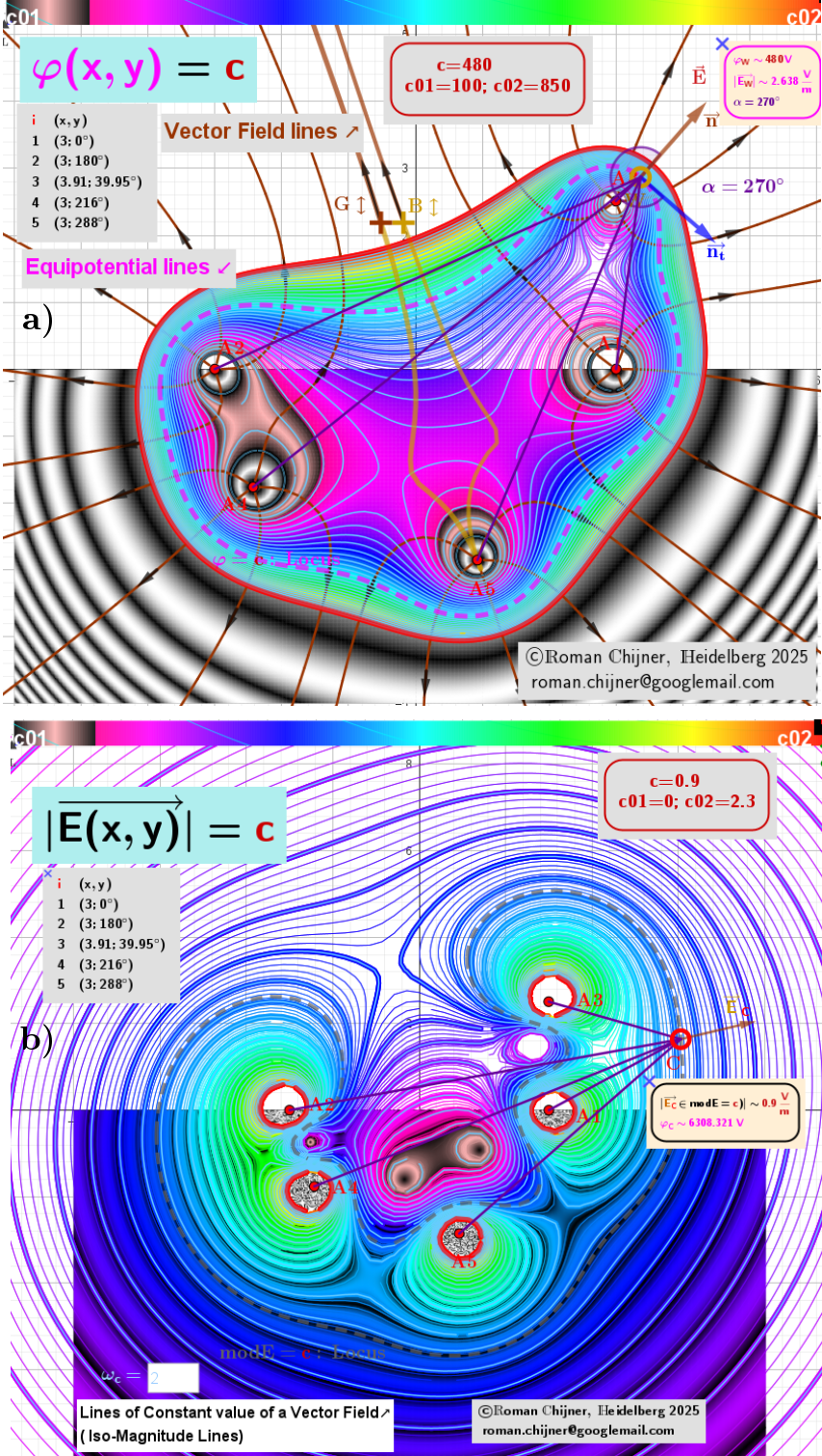[size=85][i] The [i][url=https://www.mathcurve.com/courbes2d.gb/cassinienne/cassinienne.shtml]Cassinian curves[/url] with[/i] [i][b]n[/b][/i] [i]foci[/i] (or [i][b]n[/b] poles[/i]) are the loci of the points [b]A(r) [/b]on the plane for which the [b]geometric mean of the distances[/b] to [i][b]n[/b][/i] points is constant. When [i][b]n[/b][/i] = 2, we get the [url=https://www.mathcurve.com/courbes2d.gb/cassini/cassini.shtml]Cassini ovals[/url].[br]●The purpose of the applet is to visualise [/i][url=https://mathcurve.com/courbes2d.gb/orthogonale/orthogonale.shtml]double orthogonal systems[/url][i] for [/i][color=#9900ff]scalar[/color][i] functions of the form: [b][color=#ff00ff]φ[/color][/b]([b]r[/b]) = [b][size=100]Π[/size][/b]|[b]rₖ[/b] –[b]r[/b]|, where k = 1.. [b]n[/b].[br][/i][i]●The applet constructs [/i][b]loci[/b][i]. For a [color=#9900ff]given [url=https://www.google.com/search?q=what+Scalar+field&sca_esv=b3f6a4e4ace9f962&rlz=1C1VDKB_deDE963DE963&sxsrf=AE3TifNaeH1mlgh2NkZ_lPDl2gyWT2xiLg%3A1752848303285&ei=r1d6aLOYEYmrxc8PkrqOoAs&ved=0ahUKEwjzq9njzMaOAxWJVfEDHRKdA7QQ4dUDCBA&oq=what+Scalar+field&gs_lp=Egxnd3Mtd2l6LXNlcnAiEXdoYXQgU2NhbGFyIGZpZWxkMgYQABgHGB4yBhAAGAcYHjIGEAAYBxgeMgYQABgHGB4yBhAAGAcYHjIGEAAYBxgeMgYQABgHGB4yBhAAGAcYHjIGEAAYBxgeMgYQABgHGB5I9DRQqRNYyydwAXgBkAEAmAFxoAGDBKoBAzIuM7gBDMgBAPgBAZgCBqAClQTCAgoQABiwAxjWBBhHwgINEAAYgAQYsAMYQxiKBcICBxAAGIAEGA2YAwCIBgGQBgqSBwMzLjOgB-ousgcDMi4zuAeQBMIHBTAuNS4xyAcP&sclient=gws-wiz-serp]scalar field[/url] [/color][/i][color=#ff00ff][b]φ[/b][/color][i](r), it creates [br][/i][color=#ff00ff]-equipotential lines[/color][i], and for the corresponding gradient fields [/i][b]E[/b][i](r), it creates [br]-iso-magnitude lines, which are lines of constant field magnitude ([/i][color=#1e84cc]but not their direction![/color][i]), denoted by [/i][b][color=#333333][url=https://www.google.com/search?sca_esv=9df8d0d36b3fc424&rlz=1C1VDKB_deDE963DE963&sxsrf=AE3TifOinHFuIQvbGNLrnpGmgfmwCNS3IQ:1751026231589&q=what+is+Equi-lines+potential+%CF%86+and+modE&spell=1&sa=X&ved=2ahUKEwjMxZqEyZGOAxW_FBAIHQEZGxMQBSgAegQICxAB]modE[/url][/color]. [/b][i]The vector field [/i][b]E[/b][i](r) is obtained by taking the [/i][url=https://en.wikipedia.org/wiki/Gradient]gradient[/url] [color=#333333]([size=85]Figure 1: ) [/size][/color][i]of the potential function [color=#ff00ff][b]φ[/b][/color](r).[br]● For a set of point "charges" (q[sub]k[/sub][/i]=1)[i], these [/i][b]loci[/b][i] are always closed, and the "charges" are their [/i][b][color=#ff0000]foci[/color][/b][i]. In other words, these lines are multifocal curves[/i][i].[br]● [/i][color=#ff00ff]Equipotential lines[/color][i] are [/i][color=#333333][i]always perpendicular [/i][/color][i]to the [color=#980000]field lines[/color][/i][i] of the [/i][url=https://en.wikipedia.org/wiki/Conservative_vector_field]conservative[/url][i] vector field [/i][b]E[/b][i](r), which are calculated numerically in the applet.[/i][/size]

[size=85] There are two different ways of representing loci for the system of "charges":[br]a) equipotential lines, [b][color=#ff00ff]φ(x,y) [/color]=[color=#980000]c[/color],[/b] and[br]b) lines of constant magnitudes of the corresponding conservative vector field, [b]modE =[color=#980000] c[/color][/b].[/size]
[size=85][size=100][b][u]Applet[/u]. Description of Services for the applet can be found in [url=https://www.geogebra.org/m/adevardg]1[/url]. There are 5 examples. You can download any of them [b]by clicking on the corresponding button[/b]. You will find their images in [b][b][url=https://www.geogebra.org/m/fbey4rs7]2[/url][/b].[/b][/b][/size][/size]

[size=85]a) The distribution of the scalar field [color=#ff00cc][b]φ [/b][/color]around the charges, as well as the directions of the corresponding gradient vector field [b]E[/b], where the equipotential lines ([b][color=#ff00ff]φ[/color]=[color=#980000]c[/color]) [/b]of the scalar field are closed curves whose [b][color=#ff0000]foci[/color][/b] are located on the charges and perpendicular to the field[br]lines.[br](b) Distribution of the constant value of the modulus of the vector field strength [b]E [/b]for five point charges (denoted [b]modE[/b]). In this case, the lines representing the [b][i][color=#980000]constant[/color][/i][/b] modulus of the vector field strength [b]E (modE=[color=#980000]c[/color]) [/b]always form closed curves whose [b][color=#ff0000]foci[/color][/b] are located on the charges (but not their directions!).[/size]

